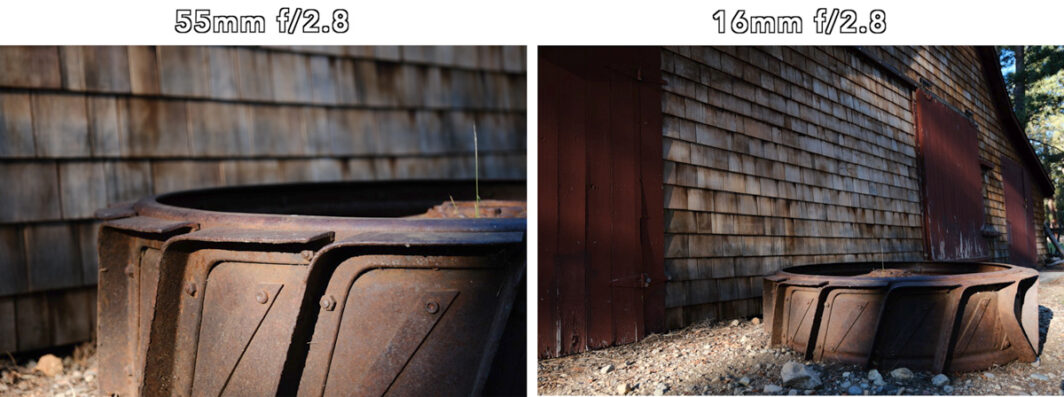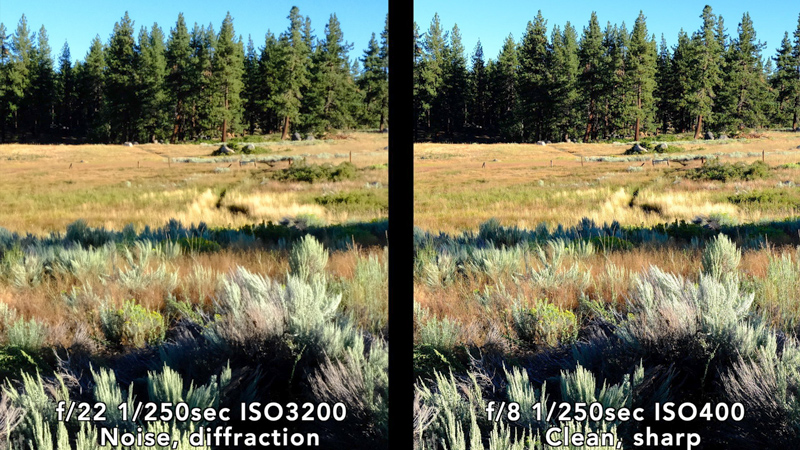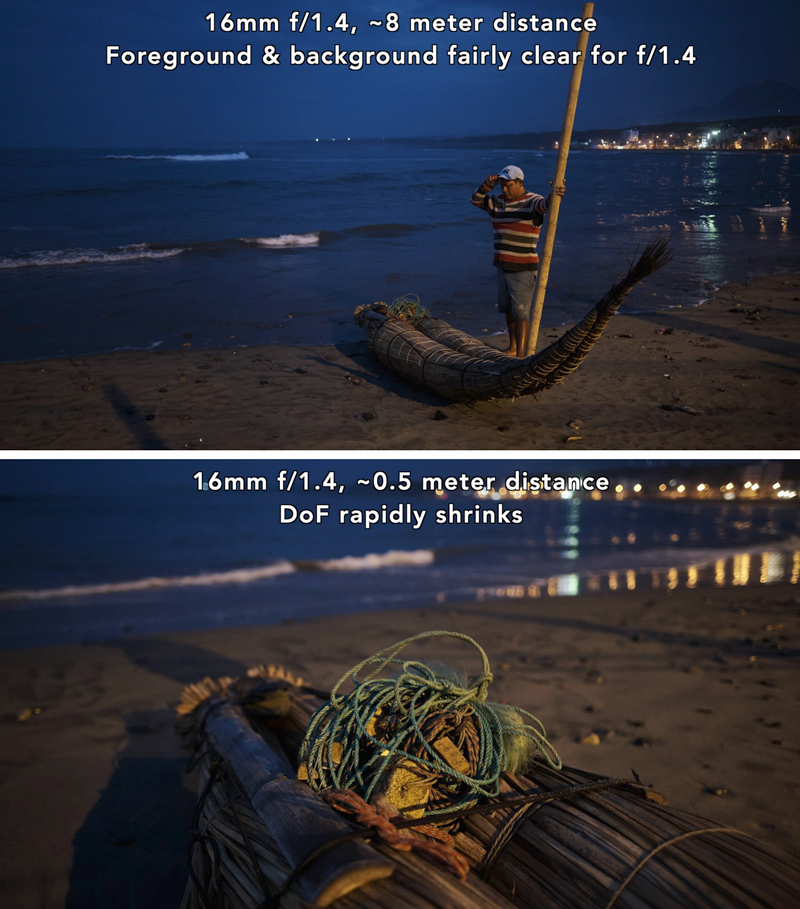Disclosure: This post may contain affiliate links. I earn a small commission of product sales to keep this website going.
When we all learn basic exposure, one of the things beaten into our brains is that small apertures (large f-numbers) create deep depths of field so we can get foreground and background in focus. Large apertures (small f-numbers) blur our background, isolating our subject.
But that inevitably leaves people to ask, I was at f/22; why is my background out of focus? Or, I bought this f/1.4 lens for beautiful bokeh, but why is my background sharp?
We need to start bringing focal length and focus distance into these early educational discussions, as these two variables affect your depth of field just as much as aperture does.
What is Depth of Field (DoF)?
Depth of Field is defined as “how much of your image appears to be in focus.”
Notice the word appears. This is the first thing worth pointing out. Depth of field is subjective, based on the viewer’s physiology.

Depth of field also depends on how your image is viewed. A large, high-resolution computer monitor at a close viewing distance? Or on a billboard from a half-mile away? A small cotton rag print from across a room?
The same image, displayed in all of those different scenarios, will have different depths of field.

The display medium determines how well we can see the Circle of Confusion, a technical topic covered in the Advanced Depth of Field course.
But this – what appears sharp and blurry – is also affected by our focal length and focus distance.
Effects of Focal Length on Depth of Field
A point of light in your scene is blurry. If you zoom in (telephoto), you’re magnifying that blurry point, making it easier to see the blur. If you zoom out (wide angle), that blurry point becomes so tiny that you can’t perceive it’s blurry.
That’s how focal length affects depth of field; what appears to be sharp. All you need to remember is the shorter the focal length, the deeper the depth of field.

Let’s look at a table to prove it. This table assumes the following: Fujifilm APS-C sensor, focus distance of 10 meters, and the distances are near DoF limit to far DoF limit (in meters).
| FOCAL LENGTH | f/4 | f/5.6 | f/8 | f/11 | f/16 |
| 24mm | 4.2m to ∞ | 3.7m to ∞ | 2.7m to ∞ | 2.1m to ∞ | 1.6m to ∞ |
| 56mm | 8m to 13.4m | 7.4m to 15.6m | 6.6m to 20.2m | 5.8m to 35m | 5m to ∞ |
| 90mm | 9.1m to 11m | 8.8m to 12.4m | 7.8m to 13.8m | 7.8m to 13.8m | 7.2m to 16.4m |
Don’t worry about memorizing the numbers or ratios. All you need to take away from this is that a large aperture doesn’t always give you a shallow depth of field, and a small aperture doesn’t always give you a deep depth of field.
With a large aperture of f/4 (textbook shallow DoF), you can get an infinite DoF using a 24mm lens. With a small aperture of f/16 (textbook deep DoF), your DoF will only be 9 meters using a 90mm lens.
If you want sharp foregrounds and backgrounds, it will be more difficult with a telephoto lens.
You also do not need to go to f/22 for an infinite DoF when using a wide-angle lens. An aperture of f/4 may do the trick, allowing you to avoid diffraction and use lower ISOs and faster shutter speeds!

Effects of Focus Distance on Depth of Field
The table in the previous section was for a focus distance of 10 meters. But what about different focus distances?
Here’s another DoF table where we adjust our focus distance using a fixed lens of 35mm focal length.
| APERTURE | 2m | 8m | 25m | 100m | 500m |
| f/4 | 1.8m to 2.3m | 5.3m to 16.3m | 9.6m to ∞ | 13.5m to ∞ | 15.2m to ∞ |
| f/8 | 1.6m to 2.7m | 4m to ∞ | 6m to ∞ | 7.3m to ∞ | 7.7m to ∞ |
| f/16 | 1.3m to 4m | 2.6m to ∞ | 3.4m to ∞ | 3.8m to ∞ | 3.9m to ∞ |
Like the previous table, don’t worry about the numbers or ratios. Just note how the depth of field increases as you focus further away, using the same lens & aperture. DoF will shrink if your subject is closer to the camera. The further away you focus, the deeper your depth of field.

You don’t need to go to f/16 to get an infinite depth of field if your closest subject is further from the camera – f/4 might give you deep enough DoF, which will, again, let you use optimal apertures for other exposure settings.
In Conclusion
Photography can get complex – but you can also really simplify it.
Yes, more than just aperture affects your Depth of Field. Display medium can sometimes be out of your control, but when making your exposure & composition decisions, remember:
- Smaller apertures give you deeper depths of field than larger apertures.
- Further focus distances give you deeper depths of field than closer focus distances.
- Shorter (wider) focal lengths give you deeper depths of field than longer (telephoto) focal lengths.
All three of those things combine to give you the final depth of field recorded by your sensor. Which will, again, further be altered by the size of your sensor and how the image is viewed.
To learn more about what affects depth of field, our Advanced Depth of Field course goes into these topics in further detail. Four short videos, a downloadable reference sheet, and a comprehension quiz will ensure you can master depth of field for the creative control you want! Use code “blog20” for 20% off.

Laura
Saturday 2nd of December 2023
John, This is so clear. I love the way you present information. It's the best and thanks for that. It's good enough so I can understand it enough to explain it to someone else. Bravo!!
John Peltier
Sunday 3rd of December 2023
Wow Laura, thank you for the feedback! I hope the course is going well and explaining it even further.